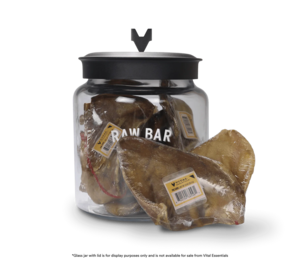Vital Essentials Raw Bar Pig Ears Review
PawDiet has been helping pet owners since 2015. To fund our efforts, articles may include affiliate links; if you buy something through a link, we may earn a commission.
Review of Vital Essentials Raw Bar Pig Ears
According to our most recent data, this product is intended for intermittent or supplemental feeding only.
Review of Ingredients
In our review of Vital Essentials Raw Bar Pig Ears, we'll examine all 1 ingredients and highlight the nutritional contribution of each ingredient.
While the first few ingredients typically dominate the recipe's composition, ingredients in small quantities can still have a meaningful impact on the overall nutritional profile of the recipe.
Pork ear is a natural, high-protein chew that provides mental stimulation and promotes dental health for your dog. It helps reduce plaque and tartar buildup, leading to a cleaner mouth and fresher breath.
Review of Guaranteed Analysis
Crude Protein (min) of 58.00%: This value indicates the minimum percentage of protein in the pet food product. In the case of Vital Essentials Raw Bar Pig Ears, the sole ingredient is pig ear, which is a rich source of animal protein. The high protein content is primarily due to the muscular and cartilaginous tissue of the pig ear, which is inherently protein-rich. This single ingredient is responsible for the entire protein content listed in the guaranteed analysis.
Crude Fat (min) of 25.00%: The minimum fat content is set at 25.00%, which is a significant amount, suggesting that pig ears are also high in fats. These fats are naturally occurring within the tissues of the pig ear, providing energy and flavor to the pet food. The fat content includes various types of fats that are part of the pig ear's composition, such as saturated and unsaturated fats.
Crude Fiber (max) of 3.00%: Fiber is typically low in animal-based products since it is generally associated with plant materials. The maximum crude fiber content in Vital Essentials Raw Bar Pig Ears is relatively low at 3.00%, which is consistent with the fact that pig ears are made up of animal tissue, not plant material. The connective tissues and any residual hair on the pig ear may contribute to this small amount of fiber. However, since pig ears are almost entirely composed of animal tissue, the fiber content is naturally minimal.

